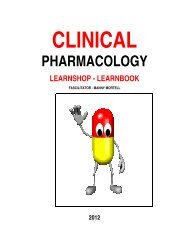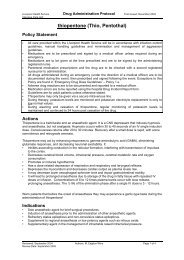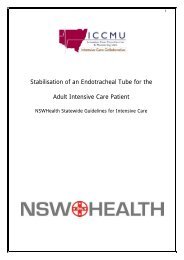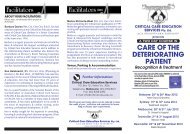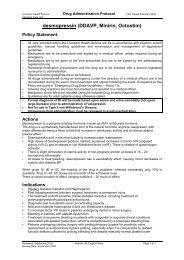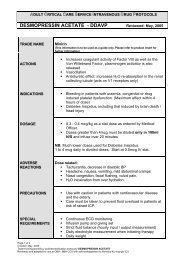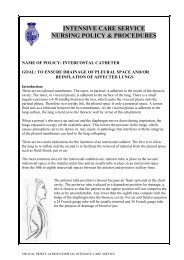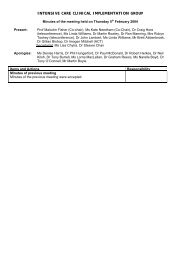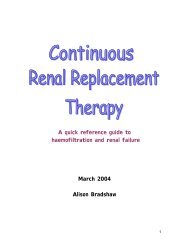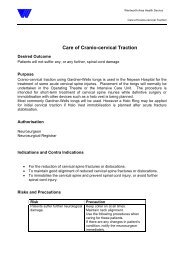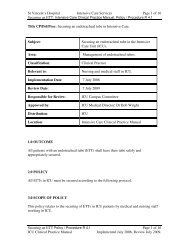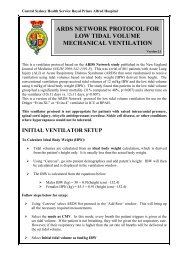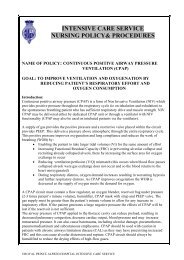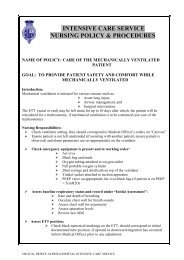Nursing care of the ventilated patient (SWAHS) - Intensive
Nursing care of the ventilated patient (SWAHS) - Intensive
Nursing care of the ventilated patient (SWAHS) - Intensive
You also want an ePaper? Increase the reach of your titles
YUMPU automatically turns print PDFs into web optimized ePapers that Google loves.
W e s t e r n<br />
S y d n e y<br />
A re a H e a lth S e rv ic e<br />
H E A L T H<br />
<strong>Nursing</strong> Care Of The Ventilated Patient<br />
<strong>Intensive</strong> Care<br />
Evidence Based Practice Guidelines<br />
2003<br />
• Closed suction ca<strong>the</strong>ters should be rinsed post suctioning to remove mucous and to<br />
reduce <strong>the</strong> likelihood <strong>of</strong> bacterial growth.<br />
• Tracheal suctioning should be attended 2 - 3 hourly, more <strong>of</strong>ten if necessary (See<br />
Suctioning an Artificial Airway Guideline).<br />
• Suction <strong>the</strong> oropharynx to remove potentially infected secretions.<br />
Monitors:<br />
• Check <strong>the</strong> level <strong>of</strong> any invasive monitoring transducers and zero <strong>the</strong>m. (Haemodynamic<br />
Monitoring Guideline).<br />
• Check <strong>the</strong> alarm parameters and reset if necessary<br />
• Document <strong>the</strong> <strong>patient</strong>’s vital signs hourly and when <strong>the</strong>re is a deviation from <strong>the</strong><br />
usual.<br />
• Check and document a manual blood pressure to assess <strong>the</strong> accuracy <strong>of</strong> <strong>the</strong> arterial<br />
trace once a shift.<br />
Oral Care:<br />
• The aim <strong>of</strong> oral <strong>care</strong> and assessment is to promote normal hygiene while preventing<br />
infection and trauma.<br />
• The presence <strong>of</strong> an ETT can cause hyper salivation in some <strong>patient</strong>s and an<br />
uncomfortably dry mouth in o<strong>the</strong>rs.<br />
• A s<strong>of</strong>t toothbrush can be used for oral hygiene and a small amount <strong>of</strong> toothpaste can<br />
help <strong>the</strong> cleansing action. Using large amounts <strong>of</strong> toothpaste may leave a residual<br />
coating and produce a burning sensation if it is not rinsed away properly.<br />
• Properly diluted sodium bicarbonate may be used to remove resistant coating on <strong>the</strong><br />
tongue, debris or tenacious secretions but again overuse may cause superficial burns.<br />
• The lips should be kept moisturized to stop <strong>the</strong>m becoming sore and cracked.<br />
• 2 nd hourly oral <strong>care</strong> is recommended, using water, not saline, and oral swabs and<br />
thorough suctioning <strong>of</strong> oral secretions, a toothbrush & paste should be used at least<br />
once a shift and more <strong>of</strong>ten if indicated.



